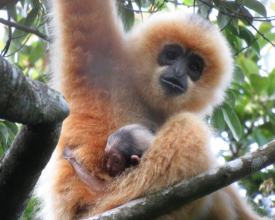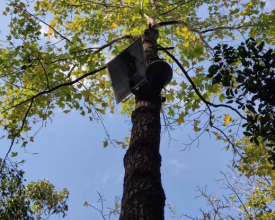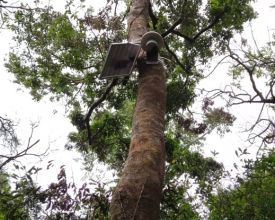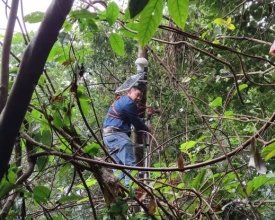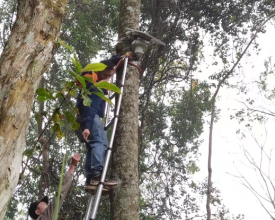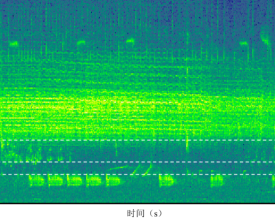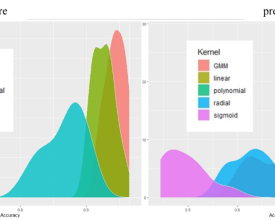
Seguimiento acústico para mejorar la conservación del gibón de Hainan, en peligro crítico de extinción
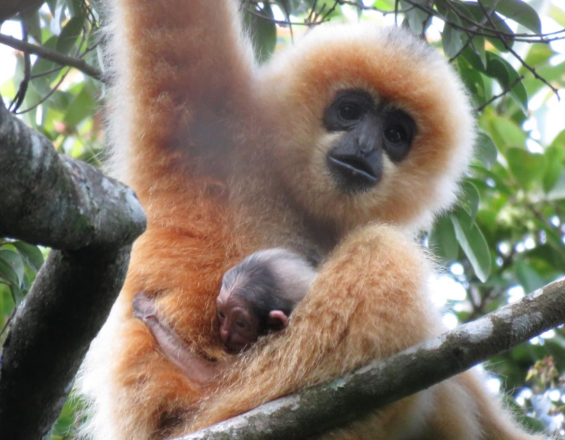
El gibón de Hainan(Nomascus hainanus) es uno de los primates más amenazados del mundo y vive en la zona de Bawangling, en la provincia china de Hainan. Para mejorar su conservación es necesario un seguimiento y una vigilancia exhaustivos, pero debido a la dificultad del seguimiento en vivo, se necesitan equipos acústicos para su seguimiento.
"Tech4Nature" es un proyecto global lanzado conjuntamente por la Unión Internacional para la Conservación de la Naturaleza (UICN) y Huawei, cuyo objetivo es desarrollar medidas de protección más científicas, combinadas con la industria de las TIC, la tecnología digital y las normas de la Lista Verde de la UICN, proporciona apoyo técnico al proyecto de seguimiento acústico de los gibones de Hainan. Hasta la fecha, se ha logrado la cobertura total de la monitorización de 5 grupos familiares, la identificación automática y la retransmisión en tiempo real de la monitorización acústica del gibón de Hainan.
Contexto
Défis à relever
- Seguimiento del gibón de Hainan
- pérdida de biodiversidad
- Relación entre el hombre y la naturaleza
Ubicación
Procesar
Resumen del proceso
Los tres bloques de construcción se llevan a cabo en orden cronológico. La investigación sobre el terreno (BB1) es la base para la disposición e instalación de equipos de grabación de sonido (BB2) y, al igual que BB2, para la cuantificación de datos y el establecimiento de bases de datos (BB3), el análisis de patrones de sonido (BB4) y el modelado de reconocimiento (BB5). Los resultados anteriores se intercambiaron y comunicaron durante el Simposio Internacional (BB6) para obtener más información. Los tres bloques comparten un objetivo común de seguimiento acústico y reconocimiento individual de los gibones de Hainan. Están diseñados para permitir la recogida, almacenamiento y análisis de datos paso a paso para alcanzar los objetivos mencionados.
Bloques de construcción
Investigación de campo
Desde finales de noviembre de 2021 hasta principios de diciembre de 2021, el Instituto del Parque Nacional de Hainan (HINP) llevó a cabo una investigación de campo en los cinco grupos familiares (grupo A - E) de gibones de la reserva y sus alrededores, con la participación de los expertos y el personal pertinentes de la Reserva de Bawangling. La investigación ha establecido 8 puntos fijos y 21 puntos de vigilancia, que cubren el hábitat de cada población de gibones de Hainan, con la participación simultánea de 48 miembros del equipo.
Factores facilitadores
- Acumulación de datos anteriores sobre el seguimiento de los gibones de Hainan
- Participación de expertos experimentados
- Apoyo del Instituto de Parques Nacionales de Hainan (HINP)
Lección aprendida
La investigación de campo ha proporcionado datos de apoyo para la protección de los gibones de Hainan, y ha desempeñado un papel clave en la captación oportuna de información y la formulación de planes de conservación.
Disposición e instalación de equipos de grabación de sonido
Basándose en los resultados de la investigación, combinados con la cobertura de la señal 4G, se instaló un conjunto de equipos domésticos de grabación automática de sonido con señal 4G, que tiene una función de transmisión en tiempo real (modelo de producto: LBird-01211) en el entorno típico de los gibones de Hainan en la Reserva de Bawangling.
Factores facilitadores
Los resultados de la investigación de campo mostraron que el grupo C y el grupo E tienen una fuerte cobertura de señal 4G, que puede cumplir las condiciones de transmisión remota para equipos de grabación según las pruebas realizadas por los técnicos. Por lo tanto, se eligieron tres y dos conjuntos de equipos para su despliegue en el grupo C y el grupo E, respectivamente.
Lección aprendida
El equipo analiza los datos sonoros adquiridos a distancia, incluida la información sobre el entorno y la ubicación, e intenta practicar el reconocimiento vocal individual en el área de disposición desde la perspectiva de la sonorización.
Cuantificación de datos y creación de bases de datos
Se importaron los datos brutos del sonido al software de análisis de sonido Adobe Audition 3.0 o Avisoft-SASLab Pro, se remuestrearon (tamaño de muestra: 44100 Hz; tamaño de ventana: 1024 puntos) y se guardaron por separado en formato WAV. Se seleccionaron formas de onda y sonogramas de alta calidad para medir las características de las llamadas de los gibones de Hainan, analizar las diferencias en los índices acústicos entre individuos y construir una base de datos de patrones sonoros del gibón de Hainan de forma individual. A continuación, realizar el reconocimiento de sonidos individuales utilizando el modelo de reconocimiento de sonidos implementado. Por último, se evalúa la eficacia de la adquisición de sonidos y la precisión del reconocimiento de sonidos. Entre ellos, la evaluación del efecto de reconocimiento de sonidos se realiza principalmente comparando con la investigación de campo y otros resultados de monitorización de sonidos.
Factores facilitadores
A partir de las características adquiridas en el dominio tiempo-frecuencia de los gibones de Hainan, se determinaron los parámetros utilizados para el reconocimiento automático junto con la base de datos vocales. Los parámetros de tiempo-frecuencia seleccionados se importaron al software de reconocimiento automático y al programa algorítmico desarrollado para identificar y extraer automáticamente las llamadas del gibón de Hainan de las grabaciones. La información, como el número de gibones que pueden estar presentes en los datos sonoros, se evalúa mediante diferentes métodos de agrupación y discriminación.
Lección aprendida
El equipo de monitorización acústica totalmente automatizado es de vital utilidad para el procesamiento de datos en este proyecto. Los datos de sonido transmitidos se almacenan automáticamente en el espacio en la nube de Huawei. Una vez establecida la base de datos en la nube de Huawei de patrones de sonido de la biodiversidad de Hainan, se podrá realizar el reconocimiento individual de sonidos.
Análisis de patrones sonoros
Se ha completado el cribado manual de 532 muestras acústicas de gibones de Hainan, incluidas las obtenidas durante el seguimiento y la observación de gibones con una grabadora portátil y las obtenidas con una grabadora automática. Durante el proceso de cribado, se categorizaron inicialmente tres calidades de grabación, a saber, alta, media y baja. Se obtuvieron 44 grabaciones de alta calidad de siete llamadores individuales. Los siete llamadores individuales eran GAM1、GBM1、GBSA、GCM1、GCM2、GDM1、GEM1, donde la letra después de "G" representa el número de grupo familiar y la letra después de "M/S" representa el número individual de macho adulto/macho subadulto. Sólo alrededor del 40,9% de las grabaciones se realizaron manualmente. Los archivos en bruto de todas las grabaciones automatizadas fueron proporcionados por el equipo del profesor Wang Jichao, y los datos relacionados se guardaron en el Instituto del Parque Nacional de Hainan.
Factores facilitadores
Los coeficientes Mel-frequency cepstrum (MFCC) son un método de extracción de características de la envolvente de frecuencia por cepstrum tras debilitar la información de alta frecuencia sobre la base de la audición humana[1], que tiene una amplia gama de aplicaciones en el campo de la bioacústica y humana. En este estudio, se utilizan los MFCC y las diferencias de primer y segundo orden (△、△2) para lograr la extracción automatizada de características.
Lección aprendida
Se han identificado 5 notas características del gibón macho de Hainan (Fig.1), incluyendo la nota boom, la nota aa, la nota pre-modulada, la nota-R0 modulada y la nota-R1 modulada.
Según la hipótesis del nicho acústico, las llamadas de las distintas especies se diferencian en los dominios temporal y frecuencial (véase la Fig. 2), por lo que la extracción de características en un rango de frecuencias específico puede reducir en gran medida la influencia del ruido, y cuanto menor sea el rango de frecuencias delineado, más probable será que se excluya más ruido. Además, cuando la estructura de cada unidad mínima de reconocimiento (MRU) es la misma, la dificultad del reconocimiento se reduce considerablemente.
Teniendo en cuenta la situación anterior, en esta fase de la investigación, probamos (1) aplicando sólo pre y (2) utilizando pre + n×mR0 como MRU, respectivamente, y comparando los resultados de clasificación para determinar la extracción de características más adecuada en el trabajo posterior. En el caso de la anotación de voz, todos los pasos anteriores pueden implementarse automáticamente mediante código en lenguaje R.
Modelización del reconocimiento
Debido al excesivo número de características, se utilizó una SVM-RFE de validación cruzada de 10 veces para clasificar la importancia de las características después de extraerlas y, a continuación, se añadieron las características secuencialmente para la clasificación LDA con el fin de registrar el cambio en la precisión con el número de características seleccionadas y, finalmente, se registró el mejor número de características como entrada para las clasificaciones posteriores (véase la Fig. 8). La mayor precisión para la clasificación LDA fue del 89,2% (pre) / 95,6% (pre + n×mR0).
Dado que ninguno de los MFCC extraídos con un número fijo de ventanas obtuvo mejores resultados que el método de ajuste GMM para la clasificación LDA (6-ventanas: 86,6%; 10-ventanas: 88,5%; 100-ventanas: <80%), probamos la eficacia de los otros clasificadores utilizando sólo las características extraídas por el método de ajuste GMM. En esta prueba, seleccionamos aleatoriamente el 20% de los datos como conjunto de prueba, y el resto de los datos se utilizaron para entrenar el clasificador, que se repitió 10 veces para cada función de núcleo para registrar la distribución de la precisión. Entre ellos, el efecto de clasificación de GMM es pobre cuando se utiliza sólo pre como MRU, mientras que el efecto es generalmente mejor que cuando se utiliza sólo pre cuando se utiliza pre + n×mR0 como MRU.
Factores facilitadores
Existen muchos clasificadores que pueden utilizarse para el reconocimiento individual. Teniendo en cuenta el rendimiento y las posibilidades de los clasificadores, esta investigación comparó la eficacia de clasificación de tres clasificadores que se han desarrollado considerablemente en el campo de la bioacústica de gibones o el reconocimiento de patrones de sonido humano, es decir, (1) análisis discriminante lineal (LDA), (2) máquina de vectores de soporte (SVM) y (3) GMM (clasificación mediante la determinación de la similitud entre los datos a medir y los datos existentes).
Lección aprendida
Se ha identificado el método básico de extracción de características de patrones de sonido y se ha establecido un método de sistema preliminar para el reconocimiento de sonidos individuales de los gibones de Hainan. Nuestros resultados preliminares demuestran que el método del sistema existente es relativamente fiable y permite alcanzar los objetivos previstos del proyecto. Entre ellos, el uso de pre + n×mR0 como MRU, la extracción de características de patrones de sonido mediante el método de ajuste GMM y el uso de SVM lineal para la clasificación serían más eficaces. En el trabajo de seguimiento, los datos de individuos raros se complementarán constantemente, y se mejorará el diseño del sistema de algoritmos, se dará la capacidad del clasificador para reconocer individuos desconocidos, y se evaluará exhaustivamente el rendimiento del sistema, para finalmente realizar el reconocimiento del sonido individual de los gibones de Hainan.
Simposio internacional
El simposio fue dirigido por la Oficina de Asuntos Exteriores de la provincia de Hainan, el Departamento de Recursos Naturales y Planificación de la provincia de Hainan, el Departamento de Ecología y Medio Ambiente de la provincia de Hainan, el Departamento Forestal de la provincia de Hainan; y contó con el apoyo del laboratorio de macrodatos del Instituto de Investigación para la Ecocivilización de la CASS, el grupo de expertos en investigación del Instituto de Investigación para la Ecocivilización de la CASS, el Instituto de Zoología de la Academia China de las Ciencias, el Jardín Botánico Tropical de Xishuangbanna de la Academia China de las Ciencias, el Instituto para la Neutralidad del Carbono de la Universidad Tsinghua, el Instituto Interdisciplinario Avanzado de Medio Ambiente y Ecología, Huawei Technologies Co., Ltd., la Universidad de Hainan, la Universidad Normal de Hainan, la Federación de Académicos de Hainan, la Base de Investigación de Sanya del Centro Internacional del Bambú y el Ratán.
El simposio, de dos días de duración, se centró en el tema de la "conservación de las especies emblemáticas de las selvas tropicales: los gibones" y la "conservación de la biodiversidad de las selvas tropicales", y se celebró combinando actividades en línea y fuera de línea.
Factores facilitadores
Con motivo del tercer aniversario de la creación del Instituto de Parques Nacionales de Hainan y del 8º Día Internacional del Gibón (24 de octubre de 2022), el Departamento Forestal de la provincia de Hainan, el gobierno municipal de Wuzhishan, la Fundación de Bienestar Público de la Selva Tropical de la Isla Verde de Hainan y el Instituto de Parques Nacionales de Hainan copatrocinaron el "Simposio Internacional de Conservación de la Selva Tropical 2022" con el lema "Proteger la selva tropical: hacer realidad los valores ecológicos", que contó con el apoyo de Eco Foundation Global (EFG).
Lección aprendida
La Conferencia alcanzó los siguientes resultados concretos
- Firma de la Carta de la GGN (Global Gibbon Conservation Network Charter).
- l Anuncio del establecimiento de la primera Secretaría de la GGN en el Instituto del Parque Nacional de Hainan, y el lanzamiento mundial del logotipo de la GGN.
- Se trata del primero de los cinco primeros parques nacionales de China, las primeras organizaciones nacionales de investigación para la conservación iniciaron el establecimiento de organizaciones internacionales para la protección de especies apreciadas, lo que tiene una importancia histórica.
- Publicar la Global Gibbon Network la declaración de conservación en forma de GGN uniendo sus manos con la UICN SSA, con el gibón como representante.
- Presentar la Lista de Especies Prioritarias para la Conservación en el Parque Nacional de la Selva Tropical de Hainan con el caso de las KBA, y publicar oficialmente la Lista de Especies Prioritarias para la Conservación en el Parque Nacional de la Selva Tropical de Hainan.
Impactos
- Mejorar la eficacia de la vigilancia: El equipo instalado en este proyecto puede ser activado por el sonido de los gibones de Hainan, luego graba los datos y los transmite en tiempo real, y también puede realizar el reconocimiento automático del sonido, lo que mejora eficazmente la eficiencia de la monitorización, y logra una nueva etapa en la monitorización acústica del gibón de Hainan.
- Ayuda a la conservación de la biodiversidad: El establecimiento de la base de datos en la nube proporcionará una base científica para el descubrimiento de posibles solitarios o grupos de gibones de Hainan, contribuyendo a la conservación de la biodiversidad en Hainan.
- Contribuir al estudio del ser humano: Los gibones de Hainan tienen un complejo sistema de comunicación acústica similar al de los humanos, y un sistema de apareamiento monógamo o bimatrimonial estable. El estudio de sus comportamientos a partir de su acústica puede ayudarnos a comprender mejor los orígenes de la sociedad humana, la familia, el lenguaje, la comunicación y la evolución de otros comportamientos.
- Aumentar la concienciación sobre la conservación: El intercambio de experiencias sobre la aplicación de tecnologías en la conservación del gibón de Hainan, basándose en la indicación y el valor de referencia de medios científicos como el reconocimiento de sonidos y el seguimiento preciso en el desarrollo estable a largo plazo de los gibones de Hainan.
Beneficiarios
- Gibones de Hainan
- Comunidades locales
- Comunidades de zonas protegidas
- Academia
- Visitantes
Objetivos de Desarrollo Sostenible
Historia

Antes, para vigilar a los gibones de Hainan, los miembros de nuestro equipo solían perseguirlos por las montañas, llevando cámaras, dispositivos GPS y otros equipos. Pero ahora, empleamos tecnología para la vigilancia inteligente de los gibones de Hainan. Por ejemplo, instalamos cámaras de infrarrojos, monitorización acústica y equipos de seguimiento en tiempo real dentro del hábitat de los gibones de Hainan. De este modo, ya no tenemos que preocuparnos de la resistencia física ni de las condiciones meteorológicas. La combinación de presencia humana y tecnología resuelve eficazmente problemas como el trabajo en condiciones meteorológicas adversas y la vigilancia durante la noche, cuando los humanos necesitan descansar. Cuando el tifón azotó Hainan, provocó corrimientos de tierra que obstruyeron muchas de las rutas de actividad de los gibones de Hainan entre las montañas. Para vigilar mejor sus rutas de actividad, instalamos un corredor de cuerdas en los valles afectados por los desprendimientos. Cerca de este corredor de cuerdas, vigilamos y observamos a los gibones de Hainan. Nos preguntábamos si utilizarían el corredor de cuerdas que habíamos construido. Al cabo de unos dos meses, nos alegró ver las primeras imágenes captadas por las cámaras de infrarrojos que mostraban a los gibones utilizando el corredor de cuerdas para acceder al hábitat opuesto. Esto nos hizo sentir que nuestros esfuerzos habían merecido realmente la pena. Los gibones de Hainan son criaturas muy inteligentes.


